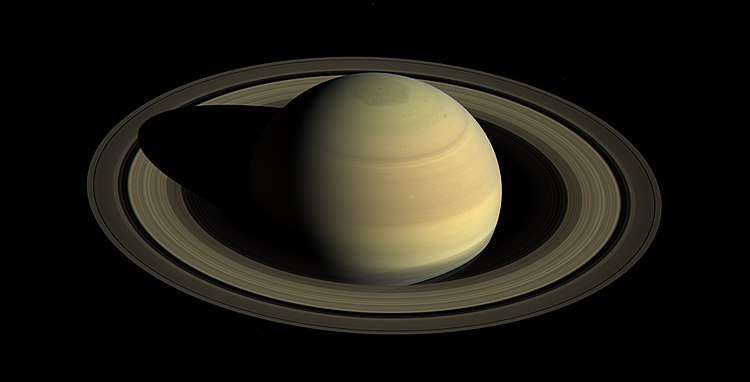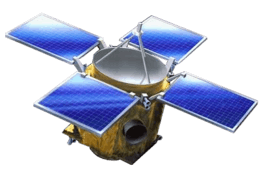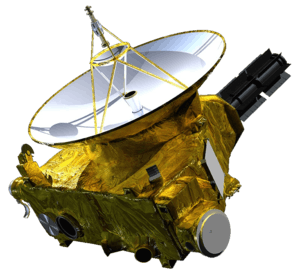SPRITE (spacecraft)
| Mission type | Atmospheric probe |
|---|---|
| Operator | NASA |
| Saturn atmospheric probe | |
| Spacecraft component | atmospheric probe |
| Flyby of Saturn | |
| Spacecraft component | CRSC |
SPRITE (Saturn PRobe Interior and aTmospheric Explorer) is a proposed Saturn atmospheric probe mission concept submitted in 2016 to NASA's New Frontiers program mission 4, but it was not selected for development.
Overview
Many fundamental questions about Saturn have not have been fully investigated at the end of the Cassini mission in September 2017, because of limitations in its implementation and science instrumentation. Direct measurements of the atmospheric structure and noble gas and elemental abundances of Saturn are needed to distinguish between competing models of Solar System formation, as well as to provide an improved context for exoplanet systems.[1] The SPRITE probe would revolutionize our understanding of Saturn's atmospheric structure and composition, and allow better understanding of extrasolar giant planets.[2]
SPRITE was proposed by Caltech's Jet Propulsion Laboratory with Principal Investigator Amy Simon at NASA's Goddard Space Flight Center, but was not selected for development. The two finalists, announced on 20 December 2017, are Dragonfly to Titan, and CAESAR (Comet Astrobiology Exploration Sample Return) which is a sample-return mission from comet 67P/Churyumov–Gerasimenko.[3]
Goals
The 2013-2022 Planetary Science Decadal Survey identified a Saturn probe mission as a high priority mission target for the NASA New Frontiers program due to the need for in-situ measurements to depths of 10 bars or more.[4] The SPRITE team explains that "to develop an improved understanding of the formation, evolution, and structure of the Solar System, it is essential that the role played by the giant planets be well understood, and this cannot be accomplished without in-situ measurements of the composition, structure, dynamics, and processes of Saturn's atmosphere." In order to accomplish this, the mission scientists have set two main goals:
- Collect and analyze evidence of Saturn’s formation and early evolution.[5][6]
- Reveal the truth beneath Saturn’s clouds.[5][6]
- Measure Saturn’s in situ atmospheric chemistry to validate condensation models and to interpret remotely observed composition
- Perform in situ characterization of Saturn’s tropospheric cloud structure to provide the ground truth basis for cloud retrieval models
- Determine Saturn’s in situ 3-D atmospheric dynamics in one location to bound global circulation and analytical models of the time-variable cloud top motions
Spacecraft

The SPRITE mission concept consists of a Carrier Relay Spacecraft (CRSC) and an entry probe that descends to at least ten bars.[7] The descent strategy calls for using a heat shield followed by a parachute that would permit up to two hours for the probe to collect data.[7] The probe would provide direct measurement of composition and atmospheric structure (including dynamics) along the probe descent path, providing science that is not accessible to remote sensing measurements.[8]
The solar powered CRSC would carry a multi-channel imager for pre-entry imaging of the location, and to provide global context imaging for the probe measurements.[7] The CSRC module would not orbit Saturn, but would flyby Saturn once to relay the probe's scientific data back to Earth multiple times through the Deep Space Network.[7]
SPRITE was proposed to launch in late November 2024 and follow an Earth-Venus-Earth-Earth gravity assist trajectory to reach Saturn in November 2034.
Payload
The proposed SPRITE atmospheric entry probe would carry a scientific instrument payload to measure Saturn's atmospheric structure, dynamics, composition, chemistry, and clouds to at least 10 bars.[6]
The conceptual payload consists of two spectrometers:[7] a quadrupole mass spectrometer would measure noble gases and noble gas isotopes with extreme sensitivity. Of particular importance are measurements of helium (He), key to understanding Saturn's thermal evolution;[6] and a tunable laser spectrometer that would measure molecular abundances and isotope ratios to determine the chemical structure of Saturn's atmosphere, and disequilibrium species such as carbon monoxide (CO), phosphine (PH
3) and ethane (C
2H
6) which can be used to infer Saturn's deep water abundance.[6]
The Atmospheric Structure Instrument (ASI) would provide the pressure and temperature profile of Saturn's atmosphere to determine the altitude profile of static stability, and when combined with cloud measurements from the nephelometer, it would elucidate processes that determine the location and structure of Saturn's multiple cloud layers. The ASI also includes accelerometers to measure entry accelerations from which the probe entry and descent trajectory can be reconstructed and the thermal structure of the upper atmosphere characterized.[7]
The Doppler Wind Experiment would provide a measure of the 3-dimensional dynamics of the Saturn atmosphere using an ultrastable oscillator, including the profile of local winds with depth and vertical motions from atmospheric waves.[6]
See also
- Galileo Probe (Atmospheric entry probe for Jupiter, entered 1995)
- Pioneer Venus Multiprobe (Atmospheric entry probes for Venus, entered 1978)
- Huygens spacecraft (carried by Cassini orbiter to Saturn's moon Titan)
- Saturn Atmospheric Entry Probe (concept for similar spacecraft entry probe for Saturn)
- List of spacecraft powered by non-rechargeable batteries
References
- ↑ Simon, Amy; Banfield, D. (11 June 2016). "Saturn PRobe Interior and aTmosphere Explorer (SPRITE)". NASA Technical Reports. Retrieved 2017-09-17.
- ↑ Chang, Kenneth (15 September 2017). "Back to Saturn? Five Missions Proposed to Follow Cassini". The New York Times. Retrieved 2017-09-18.
- ↑ NASA's New Frontier Mission Will Search For Alien Life Or Reveal The Solar System's History. Elana Glowatz, IB Times. 20 December 2017.
- ↑ Vision and Voyages for Planetary Science in the Decade 2013-2022 (PDF). The National Academies Press. 2011. pp. 15–16. ISBN 978-0-309-22464-2.
- 1 2 Simon, Amy (11 June 2016). "SPRITE - Saturn PRobe Interior and aTmospheric Explorer" (PDF). NASA. Retrieved 2017-09-17.
- 1 2 3 4 5 6 Atkinson, David H.; Simon, Amy; Banfield, Don (2017). "The Saturn PRobe Interior and aTmosphere Explorer (SPRITE) Mission" (PDF). Geophysical Research Abstracts. 19. Retrieved 2017-09-17.
- 1 2 3 4 5 6 D. Atkinson, A. A. Simon, D. Banfield, S. Atreya, J. Blacksberg, W. Brinckerhoff, A. Colaprete, A. Coustenis, L. Fletcher, T. Guillot, M. Hofstadter, J. Lunine, P.Mahaffy, M. Marley, O. Mousis, T. Spilker, M. Trainer, C. Webster. (2017). "The New Frontiers Saturn PRobe Interior and aTmosphere" (PDF). EPSC Abstracts. 11. Retrieved 2017-09-18.
- ↑ Exploring Saturn - The Saturn PRobe Interior and aTmosphere Explorer (SPRITE) Mission. Atkinson, David H.; Simon, Amy A.; Banfield, Don; Atreya, Sushil K.; Blacksberg, Jordana; Brinckerhoff, William; Colaprete, Anthony; Coustenis, Athena; Fletcher, Leigh; Guillot, Tristan; Hofstadter, Mark; Lunine, Jonathan I.; Mahaffy, Paul; Marley, Mark S.; Mousis, Olivier; Spilker, Thomas R.; Trainer, Melissa G.; Webster, Chris. American Astronomical SocietyDPS meeting #48, id.123.29. 16–21 October 2016.
.jpg)

.jpg)

